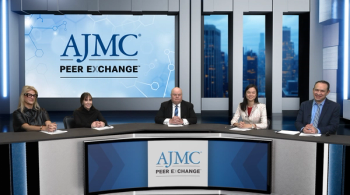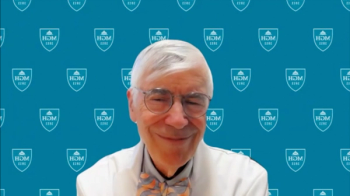
Is Remission Always Needed Before Transplant in AML? Study Says No, Could Mean Less Toxic Chemotherapy
Results from a phase 3 study of patients with acute myeloid leukemia (AML) are being presented at the 64th American Society of Hematology Annual Meeting and Exposition in New Orleans, Louisiana.
Some patients with acute myeloid leukemia (AML) could have a faster path to allogenic stem cell transplant—and less toxic chemotherapy—based on new findings that challenge conventional thinking about the best way to make a transplant successful.
The phase 3 study, called ASAP, asked whether all patients must achieve complete remission (CR) prior to allogenic hematopoietic cell transplant (allo-HCT), given the development of sequential conditioning methods with cytarabine or melphalan in the 2 weeks prior to transplant. If requiring patients to undergo intensive “salvage” chemotherapy to achieve remission doesn’t produce better results than sequential conditioning, a rethinking is in order, reasoned scientists from University of Muenster and Technical University/University Hospital, Dresden, Germany.
Johannes Schetelig, MD, MSc, professor of medicine at Technical University in Dresden, presented the findings at a press conference and will share them in a plenary session Sunday.
"We were astonished—we ever expected these results," said Schetelig, the abstract’s senior author. "Patients did not gain additional benefit from salvage chemotherapy at all. It suggests we should think about starting the process of allo-transplantation as soon as possible."
It's not that attaining CR has no link to a successful transplant. Failure to do so is a risk factor. But bombarding a patient with chemotherapy to achieve CR only works about half the time, and doing so can delay getting a patient to allo-HCT when that process would produce the best outcome, especially in an
Despite the logic of this hypothesis, investigators were amazed by the findings. For the patients not receiving salvage therapy, time to transplant was cut in half, resulting in success rates that slightly favored those who skipped salvage therapy after 8 weeks and held up after 3 years.
Of interest to payers, the patients who skipped salvage chemotherapy had fewer high-grade adverse events and spent less time in the hospital, Schetelig said. “Yet, time to discharge and in hospital mortality after transplantation did not differ between the 2 arms,” he said.
“The AML trial that is being presented in the plenary session is extraordinarily important,” said Joseph Alvarnas, MD, vice president of government affairs for City of Hope, Duarte, California, whose area of clinical expertise is in bone marrow and stem cell transplantation.
“These data show very clearly that sequential treatment that culminates in transplant represents a highly effective strategy for caring for patients with relapsed/refractory AML. This should provoke us to think more strategically and prospectively about getting patients HLA-typed and referred for transplant services as part of a coordinated episode of care that minimizes delays and maximizes the chances for survival for this vulnerable population.”
Study Approach and Methods
The approach was straightforward: investigators identified adult patients with non-favorable risk AML and randomized them 1:1 to pursue either a remission induction strategy, receiving treatment with cytarabine twice a day for 3 days followed by mitoxantrone before receivingallo-HCT; or a disease control strategy prior to sequential conditioning and allo-HCT. In the second arm, a watchful waiting approach was recommended; however, low dose cytarabine was permitted with single doses of mitoxantrone for disease control. The primary end point was treatment success, based on a measure of CR on day 56 (8 weeks) after transplant; investigators measured non-inferiority within a margin of 5%. Secondary end points were overall survival (OS) and leukemia-free survival.
A total of 281 patients were enrolled, and 276 were analyzed; 138 patients were in the disease control arm and 134 were in remission induction arm. In the disease control arm, 105 of the 138 patients stayed on watchful waiting until sequential conditioning, with 33 (24%) needing disease control treatment. In the remission induction arm, 62 patients (46%) achieved a CR, and 5 patients needed a second round of chemotherapy. The rest continued to transplant without additional attempts to induce complete remission.
Median time to transplant was 4 weeks in the disease control arm and 8 weeks in the remission induction arm. At 24 weeks post randomization, 98% and 96% of the patients had received transplants in the disease control and remission induction arm, respectively.
The primary end point was reached when 84.1% of the patients in the disease control arm and 81.3% of those in the remission induction arm; the test for inferiority was P = .047. One-year leukemia-free survival from 8 weeks post-transplant was 71.5% in the disease control arm and 69.6% in the remission induction arm.
Schetelig noted the primary end point missed statistical significance, but he highlighted the importance of the long-term outcomes. After a median follow-up from randomization of 37 months, 1 year OS was 69.1% (95.% CI, 60.6-76.1) for disease control vs 71.9% (95% CI, 63.3-78.9%) for remission induction. Three-year OS rates were 51.0% (95% CI, 41.8-59.8) and 54.2% (95% CI, 44.4-62.9), respectively.
Reference
Stellies M, Middeke JM, Bug G, et al. In patients with relapsed/refractory AML Sequential conditioning and immediate allogeneic stem cell transplantation (allo-HCT) results in similar overall and leukemia-free survival compared to intensive remission induction chemotherapy followed by allo-HCT: results from randomized phase 3 ASAP trial. Presented at: 64th American Society of Hematology Annual Meeting & Exposition; New Orleans, Louisiana; December 10-13, 2022; Abstract 4.
Newsletter
Stay ahead of policy, cost, and value—subscribe to AJMC for expert insights at the intersection of clinical care and health economics.



























































